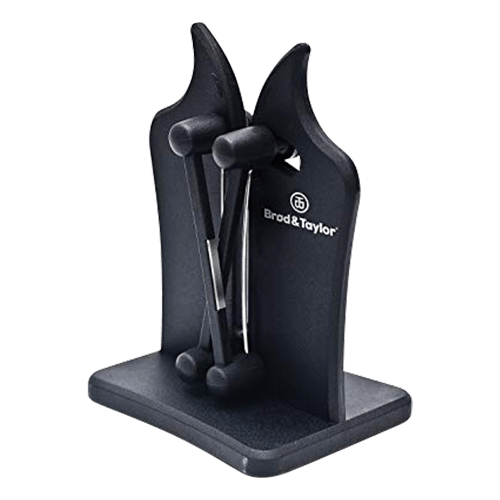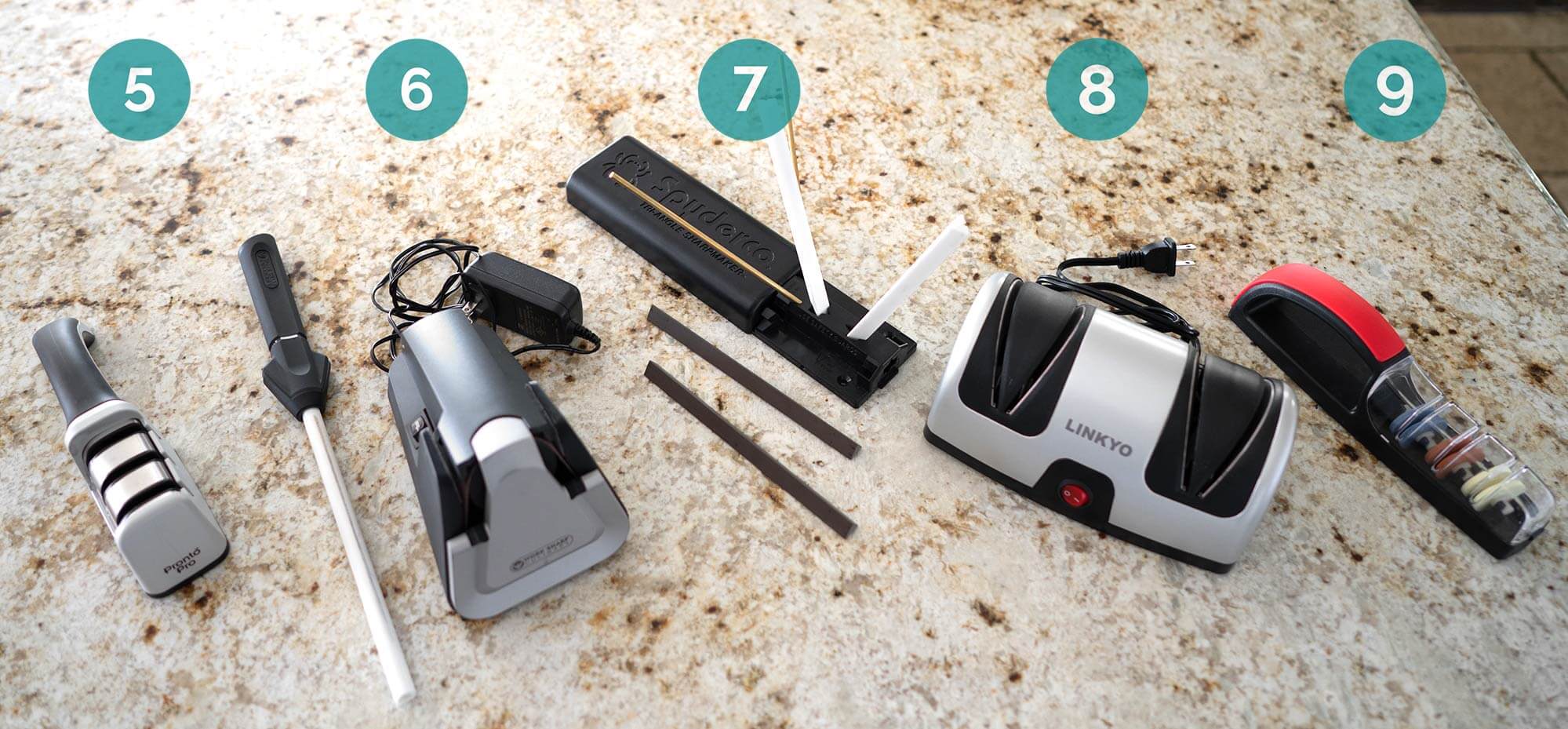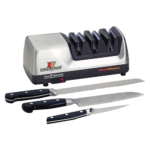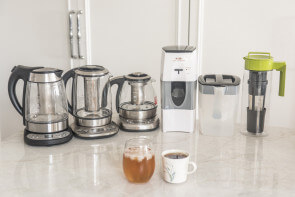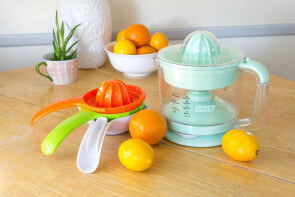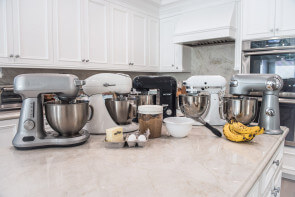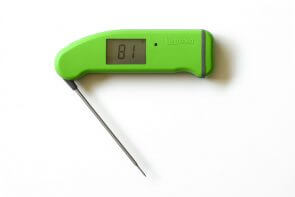
The Best Knife Sharpeners
We performed over 5,000 knife strokes and tested nine different products, both electric and manual, to pick the Chef’sChoice – AngleSelect 1520 as best knife sharpener. With diamond abrasives driven by a powerful motor, the 1520 lets you sharpen both 15- and 20-degree edge bevels so you’re not constrained to one type of knife. Its effectiveness, flexibility and solid build give the 1520 a winning edge. For a manual device, the Brød & Taylor – Classic Sharpener is our standout winner.
We performed over 5,000 knife strokes and tested nine different products, both electric and manual, to pick the Chef’sChoice – AngleSelect 1520 as best knife sharpener. With diamond abrasives driven by a powerful motor, the 1520 lets you sharpen both 15- and 20-degree edge bevels so you’re not constrained to one type of knife. Its effectiveness, flexibility and solid build give the 1520 a winning edge. For a manual device, the Brød & Taylor – Classic Sharpener is our standout winner.
Table of contents
- Compare the best knife sharpeners
- 1. Best electric sharpener: Chef’sChoice – 1520
- 2. Best budget electric: Presto – EverSharp 08810
- 3. Best manual pull-through: Brød & Taylor – Classic
- Other finalists we tested
- How we selected finalists to test
- Important features to consider
- How we tested
- How to sharpen a knife
- Professional knife sharpening services
Compare the best knife sharpeners
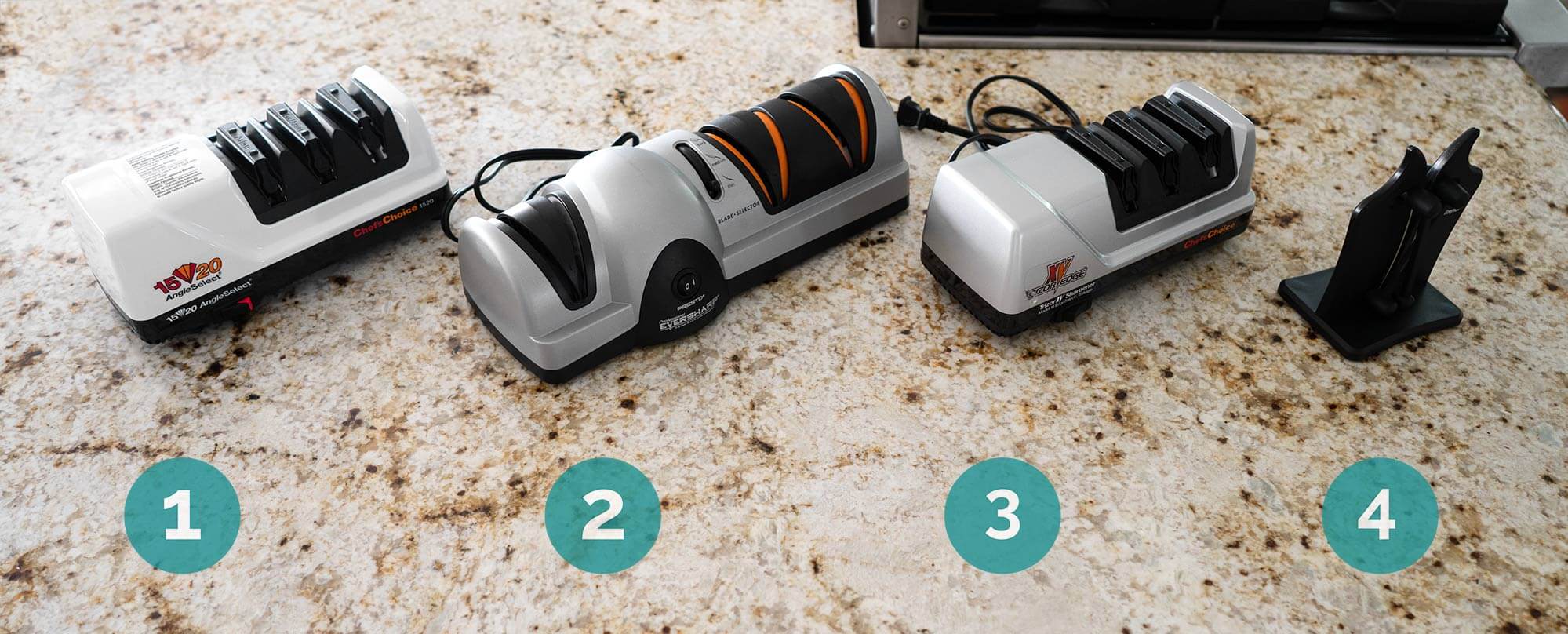
| Product | Price | Type | Effectiveness Score | Control Score | Versatility Score | Build Quality Score |
|---|---|---|---|---|---|---|
| 1. Chef’sChoice - AngleSelect 1520 | $$$$ | Electric | 5.0 | 4.0 | 4.5 | 4.5 |
| 2. Presto - EverSharp 08810 | $$ | Electric | 5.0 | 4.0 | 4.0 | 4.0 |
| 3. Chef’sChoice - Trizor XV | $$$$ | Electric | 4.0 | 4.0 | 3.5 | 4.5 |
| 4. Brød & Taylor - Classic Sharpener | $$$ | Manual | 3.5 | 3.5 | 4.5 | 4.0 |
| 5. Chef’sChoice - ProntoPro 4643 | $$ | Manual | 3.5 | 2.5 | 4.0 | 3.0 |
| 6. Work Sharp - Culinary E3 | $$$$ | Electric | 4.0 | 2.5 | 2.5 | 4.0 |
| 7. Spyderco - Tri-Angle Sharpmaker | $$$ | Manual | 2.0 | 3.0 | 4.0 | 3.0 |
| 8. LINKYO - 2-Stage Sharpener | $$ | Electric | 4.0 | 2.5 | 2.5 | 3.0 |
| 9. Global - MinoSharp 3 | $$ | Manual | 2.5 | 2.0 | 2.5 | 2.5 |
1. Best electric sharpener: Chef’sChoice – 1520
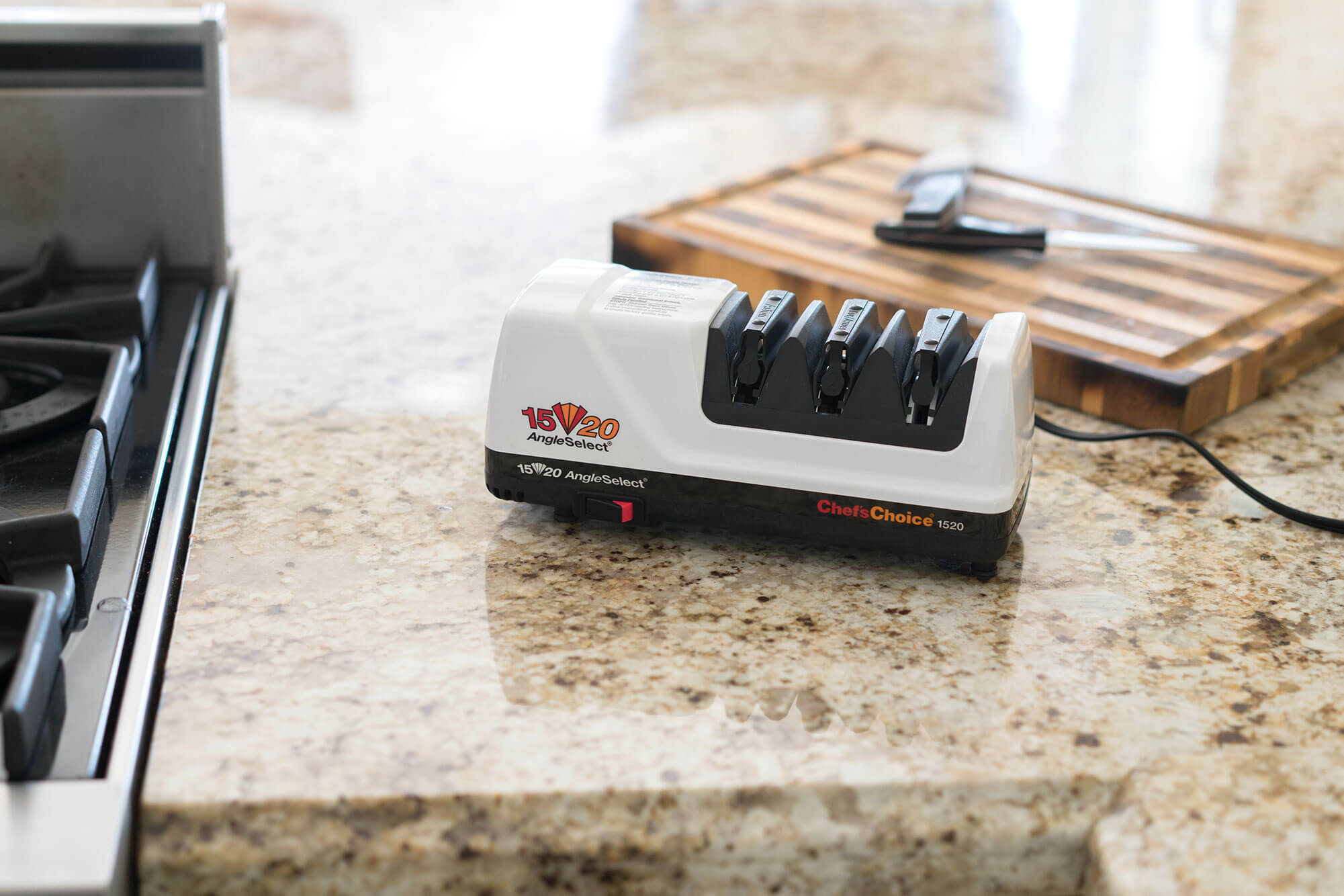
Of all our electrics, the Chef’sChoice – AngleSelect 1520 is the only model to sharpen both 15- and 20-degree angles, making it the most versatile in our group of five. This setup lets you sharpen older Western-style knives as well as newer blades. And though most knife manufacturers have changed to 15-degree bevels, you might still want the freedom to use a 20-degree edge; for example, if you’re chopping lots of hard foods like boned meats, a 20-degree edge will hold up longer.
As a tradeoff for that flexibility, the 1520 has three slots but actually only two abrasive stages. The first pair sharpens to 15-degrees, the second pair sharpens to 20 degrees and the third pair polishes both angle types. So for any given knife, you never run the blade through all three slots. Still, we think the extra versatility is worth it.
Losing one abrasive stage certainly didn’t hold back the 1520 in our tests. It outperformed other finalists by consistently producing very sharp edges on all our knives; each set of BESS measurements was nicely clustered and averaged out to 280, and in a few cases they came out sharper than new. The 1520 had no problem restoring a dulled edge on old and new knives alike, whereas some contenders just couldn’t get there. With each test, the 1520’s robust motor powered through and never faltered or bogged down.
Chef’sChoice products are made by the EdgeCraft Corporation located in Pennsylvania. One might argue they dominate the world of sharpener products with their robust line of both electric and manual devices (you’ve probably noticed that three of our nine finalists are Chef’sChoice products). They even manufacture electric sharpeners for Wüsthof and Mercer.
Both our Chef’sChoice finalists are worthy examples of EdgeCraft’s signature high quality. – For each abrasive stage there are two angled slots that separately sharpen each side of the blade, which is the ideal way to form a burr. Although housed in white plastic, the 1520 feels substantial and has a nice weight, presumably due to the large 125-watt motor that fills the housing. Pedestal rubber feet help it rest stable and secure on a countertop. A single power button keeps controls simple.
For added convenience, the 1520 has a removable magnet molded into its underside that collects metal shavings. You still need to wipe some metal dust from where it falls around the slots, but the magnet handles most of the cleaning. It’s a great idea and appears to be included in most Chef’sChoice electrics.
Also common to their electrics, Chef’sChoice touts “flexible spring guides that provide accurate control of the sharpening angle, for the thickest or thinnest knife blades.” Although marketed as an “advanced” feature, we found the spring-loaded guides to be more annoying than helpful. It’s awkward to start each pass because you have to work your blade between the two plastic guides. That makes it challenging to keep up a smooth rhythm. Also, some knife handles don’t fit, so you can’t sharpen to the very back of heel. In testing the 1520, this was our biggest frustration, but that’s fortunately our only gripe.
In case you’re concerned about long-term durability, the 1520 comes with a three-year warranty; plus, EdgeCraft is well-established company. Moreover, their FAQ web page includes this reassuring info: “If the abrasives need replacement, you may send the sharpener back to EdgeCraft and, for a nominal fee, EdgeCraft will replace the abrasives, clean and lubricate the sharpener and ship it back in almost new condition.” The replacement fee for both the 1520 and the Trizor is $45, plus shipping costs.
Key takeaways:
- The Chef’sChoice – AngleSelect 1520 provides flexibility to sharpen both 15- and 20-degree edge bevels.
- A hefty motor powers diamond abrasives that separately sharpen each side of a knife in angled slots.
- Removable magnet collects metal shavings deposited into housing.
- Comes with 3-year warranty, and Chef’sChoice can install replacement disks when abrasives wear out.
2. Best budget electric: Presto – EverSharp 08810
Despite its much lower price point, the Presto – EverSharp 08810 performed remarkably well in testing. In fact, it restored some of our test knives significantly faster than any other contenders, including the high-end electrics. This earned it not only our budget winner, but nearly compelled us to name it our top pick. However, the Presto only sharpens 20-degree blades, which most major knife manufacturers have phased out of production in favor of 15-degree edges. Although that limitation held it back in overall ranking, it’s a great option if you only own 20-degree blades.
The Presto is one of our only electrics (other than the Trizor XV) that truly performs three-stage sharpening. That increases its versatility, making it handy for both reprofiling and periodic maintenance. It uses Sapphirite abrasives (essentially aluminum oxide) for coarse and medium grinding, plus a ceramic disk for fine polishing. All stages feature angled slots to separately sharpen each side of knife.
In addition to the Presto’s fast and effective sharpening, we really appreciated its excellent control. Our other electrics impregnate abrasives onto metal disks of surprisingly thin-gauge material that are made further flexible by spring axles; they allow for a lot of give. By contrast, the 120-watt Presto uses 5/8″ thick, solid abrasive disks that are firmly fixed in place. We found this design helped us establish and maintain much better contact against the full length of the knife as we passed it through. That’s important for shaping a consistent edge.
Though made with all plastic, the Presto has a substantial feel. It weighs in at 4.8 pounds, slightly heavier than our sturdy Chef’sChoice 4.4-pound models. At just over 13.5” in length, it’s also the longest of our finalists, yet still sized for convenient storage. Five suction-cup feet add to its already hefty countertop stability. And while not part of our ranking system, the Presto scores on style for its modern silver-and-black housing with bright orange guides that offer a fun punch of color.
Perhaps its most unique feature, the Presto is designed with an adjustable blade guide, labeled as thick, medium and thin. We contacted a rep and learned these adjust to roughly 23, 21 and 19 degrees. However, the guides don’t lock into position, but rather allow quite a bit of give, which the rep confirmed is by design. It’s actually meant to accommodate different thickness blades, not to set a bevel angle. Too bad these guides aren’t more rigid because that would solve the problem of electrics not being able to adjust for different edge bevels.
Of course, while the Presto comes at an appealing price, it falls short in a couple areas. First, the warranty is only good for one year, compared to three years offered by our high-end electrics. And unlike the Chef’sChoice electrics, there’s no option to replace disks with fresh abrasives. Still, those are minor drawbacks relative to such strong performance at very reasonable cost.
Key takeaways:
- A top performer in our tests, the Presto – EverSharp 08810 delivers very fast and effective performance.
- Thick abrasive disks make it easy to maintain continuous contact as you pass the blade through.
- Unique guides can be set for thick, medium or thin knives.
- Substantial weight and suction-cup feet enhance countertop stability.
- Designed for 20-degree edge bevels, so not suited for 15-degree knives.
3. Best manual pull-through: Brød & Taylor – Classic

The Brød & Taylor – Classic Sharpener is one of the more unique products on the market. It features two spring-action bars, each inset with a bar of tungsten carbide, that form a “V” and open to different angles depending on pressure applied. Hand position determines which part of the bar you’re running the edge across: knife tip down for coarse shaping on a scraping edge, knife tip up for smoothing on a beveled edge, and knife held level for burnishing between the flat plates. You can also sharpen serrated knives by using only one side of the “V.”
The company website states that the spring-action bars automatically adjust for different blade angles. Be aware this isn’t as accurate as devices with fixed angles set at 15- or 20-degrees; if you apply too much pressure, the “V” opens to a more obtuse angle. With a bit of practice, you can learn to find the right amount of pressure, typically at a point when the rods first start to separate.
Once you get a feel for when the carbide plates are doing their work, it’s very simple to control. The Brød & Taylor certainly feels a lot gentler on knives than slotted pull-throughs with angled wheels. For longer knives, you may find that your knife tip hits the countertop when performing the tip-down coarse grinding for stage one. We learned it helps to use the device at edge of counter where the blade can extend further down.
The Brød & Taylor performed well in both our edge restoration and maintenance tests. It restored our new 7.5” chef’s knife to a sharpness level on par with our electrics — and did so in a similar number of passes. That said, it struggled to restore our other kitchen knives, which suggests it’s not as universal as the electrics. We also noticed that the initial coarse stage did a lot more work than the smoothing and burnishing stages. Still, the B&T scored well in our edge maintenance test, where it dominated the other manual pull-throughs by sharpening in dramatically fewer passes.
One negative we can point to is the B&T’s slot width. The tops of the V-configured rods are only separated by a half inch. So if you have a knife with a fatter handle, say 5/8″ or 3/4″ wide, you can still push it through (in order to sharpen heel of blade) but that opens the rods to a wider V-slot which in turn creates a more obtuse edge bevel. It’s something to be aware of if you plan to sharpen wide-handled knives.
With regard to style, the Brød & Taylor truly owns its cutting-edge look. We tested the less expensive polymer model to keep costs down, but the B&T is also available in a brushed stainless steel upgrade if that better matches your kitchen décor. And if you prefer not to keep on countertop, it’s small enough to easily slip into a drawer.
Key takeaways:
- The Brød & Taylor – Classic Sharpener sharpens knives more gently and with fewer strokes than other pull-throughs that use abrasives.
- Unique three-stage sharpener uses different knife-tip positions (up, down, level) to shape, smooth and burnish.
- Spring-action tungsten carbide inserts can be expected to last five years, and replacement rods are available when needed.
- Innovative design adds an interesting design touch to your kitchen countertop or easily stows in a drawer.
Other finalists we tested
Chef’sChoice – Trizor XV
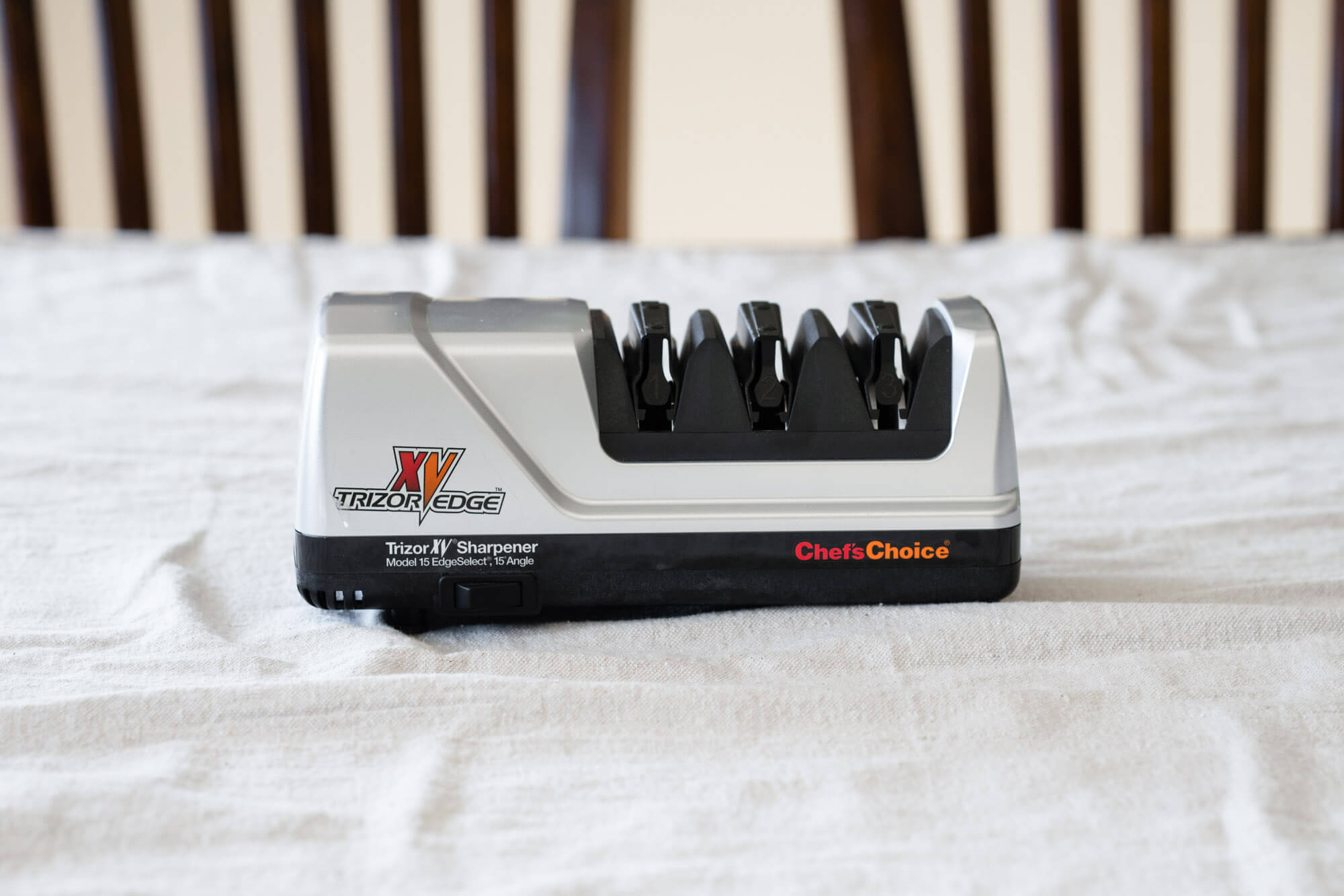
The Chef’sChoice – Trizor XV incorporates many of the same winning features (solid build, strong performance, etc.) and minor annoyance (fussy guides) as our top-pick 152o. We’re not going to repeat these common properties here (see above for that) but rather focus on what sets these models apart.
Two interrelated features differentiate the Trizor XV from the EdgeSelect 1520: number of stages and type of edge angles. Unlike the 1520, the Trizor XV is a true three-stage electric sharpener. It uses diamond abrasives for coarse and medium grinding, plus a patented synthetic for the polishing stage.
Chef’sChoice heavily promotes that the stage-one abrasive can even reprofile a knife from a 20- to a 15-degree edge bevel. The company also describes that the Trizor XV creates a “triple-bevel arch-shaped” edge that cuts cleaner and lasts longer. We can’t vouch for those since claims since we didn’t test for long-term edge durability. What we can report is that the Trizor — for whatever reason — struggled to sharpen both our old thrift store blade and new 5.5” utility knife. Even with our new 7.5” chef’s knife, it took significantly more passes to achieve only marginally better results than the 1520.
We can’t offer an explanation as to why the highly reviewed Trizor XV fell short in our edge dulling and restoration tests. We can only report the numbers as measured. On that front, in our two test knives that the Trizor XV proved most successful with, it attained higher sharpness levels — to a degree equivalent with a utility razor blade — than any other finalist. Unfortunately, it didn’t perform as well for our other test knives.
Here’s something to be aware of: The Chef’sChoice website specifies that the Trizor is available in “brushed metal.” That’s not true — it’s plastic. While it’s made to simulate metal appearance, it’s still plastic. So if you’re looking to pair the Trizor next to that brushed stainless steel toaster, don’t expect to get the same lustrous finish.
Despite inconsistent results, the extreme sharpness we achieved in some tests gives us hope that it simply takes more time to master the Trizor’s subtleties (such as when to shift stages). It remains a solid product that we don’t hesitate to recommend. Still, we prefer the 1520’s dual-angle versatility, which is the main reason we picked it over the Trizor XV.
Chef’sChoice – ProntoPro 4643
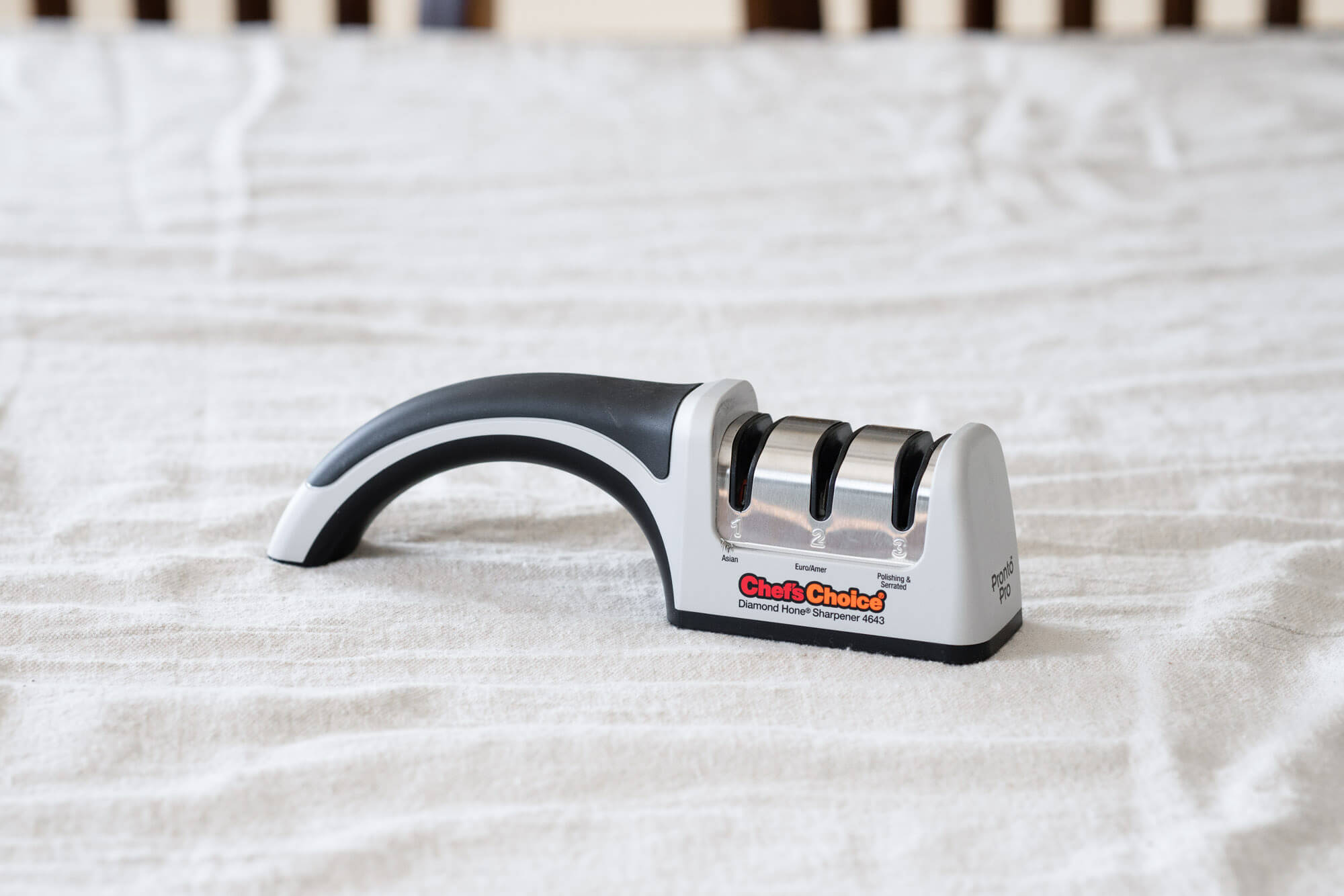
Top in their line of manual pull-throughs, the Chef’sChoice – ProntoPro 4643 is a three-slot, two-stage sharpener. Similar to their 1520 electric, slot one sharpens to 15 degrees, slot two sharpens to 20 degrees and slot three polishes both angles. All three slots use skewed metal wheels coated with diamond abrasives. As described on the Chef’sChoice website, the ProntoPro “CrissCross” technology sharpens both “into” and “out of” the knife edge. They claim this design creates a “highly effective, extremely sharp, burr-free edge with microscopic teeth.”
Despite the claim, the ProntoPro struggled to restore our dulled knives during testing, pretty much as expected. After 400 passes with our 8” thrift store knife, the PT50B device measured barely any improvement at all, forcing us to abort the effort. Our new 5.5” and 3.5” knives showed some improvement, but remained quite dull. However, we were impressed the ProntoPro could actually restore a blunted edge on our 7.5” chef’s knife, taking it to a sharpness level that cleanly sliced paper.
The ProntoPro did a much better job in our edge maintenance test, confirming what other reviewers reported. It readily outperformed our other slotted pull-through, the MinoSharp 3, achieving superior sharpness in roughly a third fewer passes. From a control perspective, it felt unpleasantly awkward to perform the ProntoPro’s recommended back-and-forth strokes; the knife edge tends to lock up in the wheels every few strokes. It helps to ease back on pressure, but the instructions say to push down with 4-5 pounds of pressure, so it’s a balancing act.
Ergonomics-wise, the device offers a firm grip for the required back-and-forth strokes. The top of the handle is rubberized and the proportions feel just right. All in all, the ProntoPro is a sturdy little device that’s well-designed for countertop use. It’s also small enough to fit in a kitchen drawer.
While the ProntoPro is not the best choice for restoring a dulled knife, it does a decent job refining a blade that is already fairly sharp. This type of light maintenance, where you don’t need to push down too hard, helps mitigate our issue with the wheels locking up. Of all finalists, the ProntoPro requires the least setup or manipulation, making it an efficient go-to solution.
Work Sharp – Culinary E3
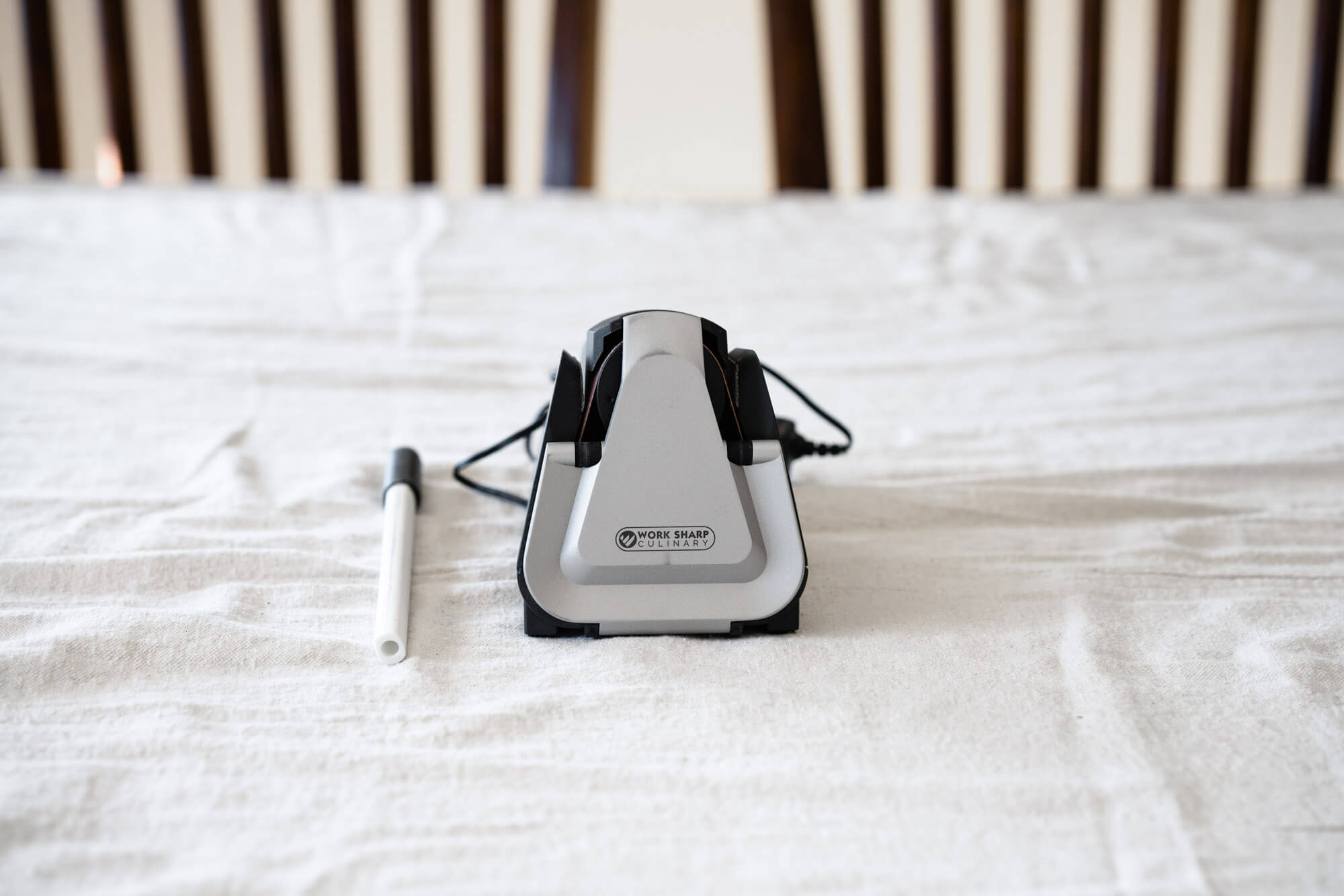
Of all nine finalists, the Work Sharp – Culinary E3 is our only belt sharpener. Taking its cue from Work Sharp’s highly respected but more utilitarian WSKTS model, the E3 (and E5 upgrade) is their first foray into sharpening knives. Introduced in late 2017, this stylish little unit takes up minimal counter space and easily tucks away in a cupboard.
The E3’s single abrasive belt is located toward the front face and reminds us of the fan belt on a car engine. You sharpen the knife by alternating pulls through left/right slots at the unit’s tapered top. Angled guides help set the knife bevel. Work Sharp opted for 17 degrees, a middle ground between standard 15- and 20-degree angles.
Instead of different abrasives, the E3 includes a fairly coarse 120-grit belt and has two speed settings: one for sharpening and one for “refining.” It also comes with a separate ceramic rod for polishing or maintenance touch-ups. Compared to our other devices that offer all-in-one solutions, this seems kind of like cheating. However, Work Sharp thoughtfully included two angled guides that make this rod simple to use.
We found it odd that the belt drive only cycles in a counterclockwise rotation. As you pull the knife through the left side, the belt abrades metal toward the blade’s apex. But as you draw the knife through the right side, the belt abrades away from the apex. Not only does this deviate from traditional methods for forming a burr, but it creates such strong friction on the left side that it essentially sucks down the blade. The E3 achieves a decent level of sharpness, but its unwieldiness makes it very difficult to sharpen a consistent edge.
Spyderco – Tri-Angle Sharpmaker

Of all finalists, the Spyderco – Tri-Angle Sharpmaker comes closest to traditional whetstone sharpening. The device includes two abrasive rods that you insert in a plastic base to form a “V” shape; each side of the “V” is angled for either 15- or 20-degree bevels. You then hold the blade in a pure vertical orientation and draw it down and toward you against the rods. Compared to our other contenders, the Sharpmaker feels by far the most natural way to sharpen a knife as well as the least risky for chipping or oversharpening.
The Sharpmaker also offers the most versatility. Because the rods are open and the blade isn’t constrained by a fixed slot, you are free to adjust the knife for slightly different angles. You can even use the rods laying flat in the bottom of the base like a traditional bench stone, or pull them out to use like files. That freedom also means you can sharpen a wide variety of tools. In addition to most any knife type, the Sharpmaker works on scissors, fishing hooks, wire cutters, screwdrivers, chisels and even pinking shears.
Further expanding its versatility, Spyderco offers different abrasive rods to insert in the Sharpmaker base. In addition to the basic kit’s medium- and fine-grit stones, you can also purchase ultra-fine, diamond and “cubic boron nitride” stones as accessories (the latter CBN stones are similar to diamond abrasion but should last longer). Rods are sold in pairs and range in price from about $15 to $50.
So with all those positives, why have we not named the Sharpmaker one of our winners? The problem comes down to the abrasives included in the base package. Per the description on Spyderco’s website: “The Sharpmaker system includes two sets of high-alumina ceramic stones — a pair of medium-grit (brown) stones for aggressive sharpening and a set of fine (white) stones for professional-grade finishing.” During our research phase, we contacted their support team to confirm that the Sharpmaker could restore an edge to a damaged knife, and we were advised the medium stones could indeed reprofile an edge to an apex.
Unfortunately, we could not get the medium-grit rods to restore either a severely worn or moderately rolled edge in our tests. Without buying more aggressive rods, we could not test it on an even playing field with our other finalists. We dug a little deeper and learned that Spyderco’s high-alumina ceramics use micron-sized particles roughly half the size of most “fine” diamond abrasive in other systems. It appears this makes them more appropriate for making sharp blades even sharper (i.e., starting to do their job from where other sharpeners leave off).
We’re confident the Sharpmaker is a fine product because two of the professional cutlers we spoke with (Frank and Josh) each shared that they regularly use it to supplement whetstone sharpening. We really appreciate the Sharpmaker’s natural feel, and its technique is very simple to learn. Though it didn’t deliver great results for our specific tests, that might be one of its strengths: Because it gradually abrades metal, it’s the least likely of our devices to cause damage — in fact, we wouldn’t hesitate to use the Sharpmaker on even our high-end cutlery.
If you want to restore even moderately dulled blades, be prepared to invest in Spyderco’s diamond rods or CBN rod sets that each cost around $50. That might seem a steep price for an add-on item, but such flexibility opens a wide range of sharpening options and allows you to replace abrasives as they wear out over time.
LINKYO – 2-Stage Sharpener

Second of two budget electrics we tested, the LINKYO – 2-Stage Sharpener is about two-thirds the size and cost of the Presto. It also features only two sharpening stages rather than three. Both stages use diamond abrasives, one for coarse sharpening and the other for fine polishing (though to our ears it sounded more a grind than a polish). Like the Presto, the LINKYO includes suction-cup feet to hold it in place and removable plugs to empty out metal shavings.
For a budget product, the LINKYO seems a fine compact unit; it’s just not all that remarkable, especially compared to the Presto. The LINKYO shaped knives to a similar sharpness as our other electrics (as tested with our BESS device). But we found control to be an issue. That’s because its abrasives are impregnated on metal disks not only very thin in gauge but also small in diameter. It felt less firm as we drew our knives, and it also produced a tinny noise.
Not to pile on, but it’s worth noting the LINKYO comes with barely any instructions and no direction at all on how many passes to make through each slot.
GLOBAL – MinoSharp 3
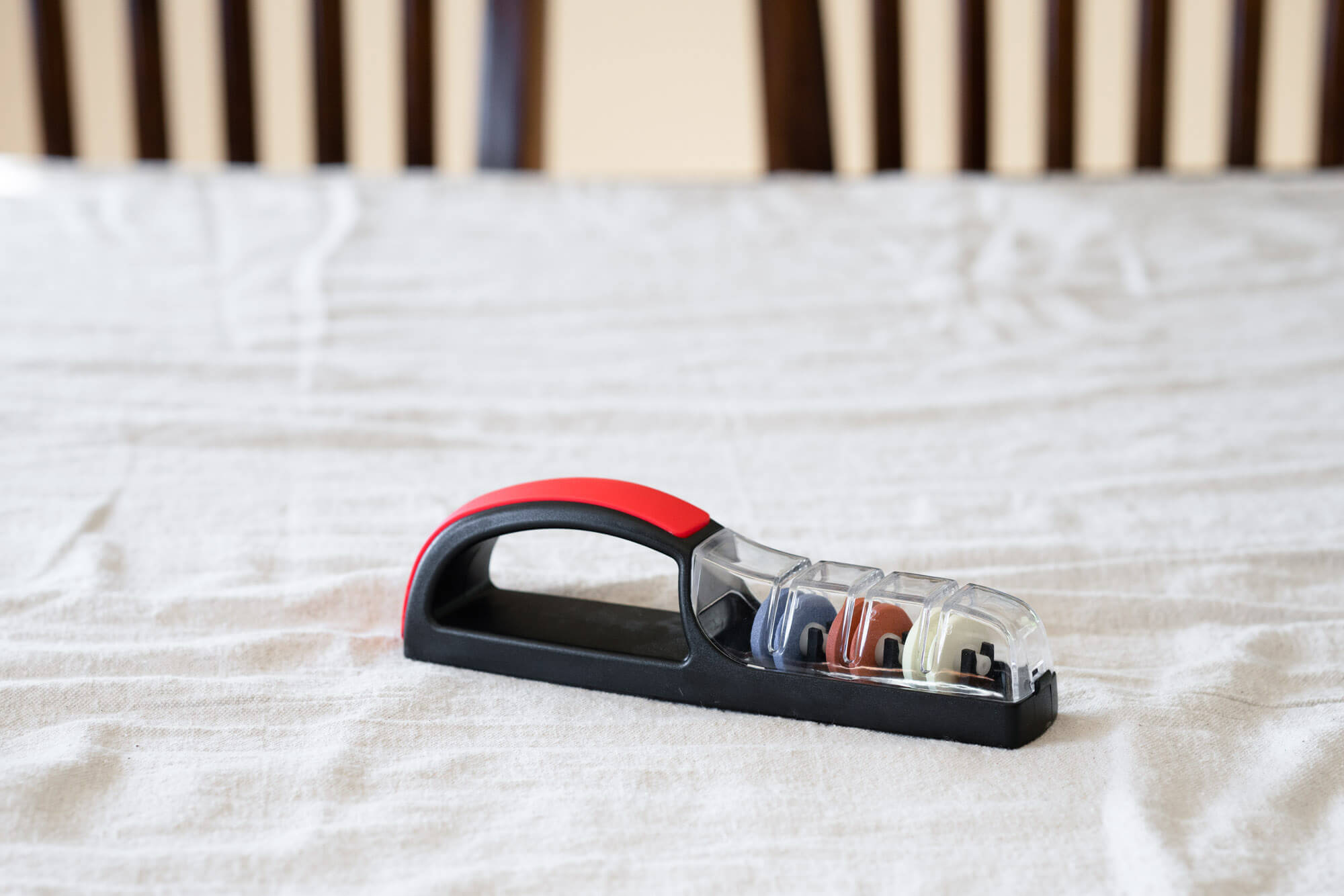
Second of our two slotted pull-throughs, the GLOBAL – MinoSharp 3 is our only finalist that uses ceramic abrasives in all three slots. It’s also our only device that incorporates a water trough. Each ceramic wheel rests halfway in a trough and is skewed at an angle to its knife slot. And that’s where our complaint lies: Like the ProntoPro, the knife tends to get stuck in the groove cut into each wheel’s center. It’s very awkward unless you apply barely any pressure, but then the abrasives don’t do their job.
We didn’t notice that the water added any improvement; it’s not like the wheels move fast enough for the blade to require cooling, as with a traditional water wheel. The trough actually adds extra steps (to fill and empty), but the flip-top does make it easy to clean, unlike other handheld pull-throughs that can clog with metal.
Novelty aside, the all-plastic MinoSharp 3 just didn’t deliver on performance. In testing, we could not get it to restore a dulled blade (we abandoned the cause after 600 strokes). It did okay, but not great, in our edge maintenance test. The problem with the MinoSharp 3 is that the ceramic wheels aren’t as effective as more aggressive abrasives in other devices. Another shortcoming is that it only sharpens 15-degree knives, but that’s a minor issue compared to its subpar performance.
How we selected
A sharper knife is safer knife. That’s because a dull knife can twist askew under pressure and cause injury. And whether amateur cook or home gourmet, you’re much more likely to maintain sharp knives if you can readily perform the task right on your kitchen counter. We set out determine which knife sharpener best solves people’s cutlery maintenance needs with respect to learning curve, effectiveness, cost and especially convenience.
Our initial research took us to expert sites like KnifePlanet.com and KitchenKnifeGuru.com, knife enthusiast sites such as BladeForums.com, plus videos from renowned bladesmith Murray Carter and YouTube phenom Ryky Tran. We honed up on traditional versus modern practices, the different grades and types of abrasives, and more. It quickly became clear there are many ways to sharpen a knife — and many different opinions about which method is best.
Informed by the pros’ perspectives, we hopped on Amazon to learn which products appeal to consumers. Our analysis revealed a divide based on user group and knife type. Home cooks prefer to sharpen their chef’s knives with simple devices that do not require training, setup or cleanup. On the flipside, people who own utility, hunting or tactical knives are more apt to commit time toward mastering traditional whetstones or pricey jig systems. Since home chefs value convenience over a mirror-polished edge, we determined not to review whetstones or advanced systems — those methods are best left to expert shops or to enthusiasts who set up on a garage workbench.
With our focus narrowed on easy-to-use devices, we dove deeper into electric knife sharpeners and manual pull-throughs. Consumer review sites like Wirecutter, Cook’s Illustrated, and America’s Test Kitchen helped confirm our top candidates. We also reached out to professional sharpeners Frank from The Art of Sharp and Josh from Razor Edge Knives who both graciously shared their insights on abrasives and manual devices. To close out our research, we contacted the major knife manufacturers to learn which sharpening methods they recommend for their cutlery lines.
All this study guided product selections. Our finalists include five electric knife sharpeners (three high-end, plus two budget) and four manual sharpeners (two with triangulated rods, plus two slotted style). To allow for fair comparison, we tried to keep each group at a similar price point. We believe this well-rounded ensemble provided ample opportunity to assess the pros and cons, and offers consumers a wide range of costs to pick from.
Important features to consider

Bevel angle
Kitchen knives are typically described as having edges factory-sharpened to a 15- or 20-degree bevel. The bevel angle is usually measured for each side of the knife, though it’s sometimes listed as “inclusionary” in which case the number is doubled (30 or 40 degrees for 15- and 20-degree knives, respectively).
The bevel angle is an important factor. You’ll want a sharpener that’s shapes an edge profile appropriate for the majority of your knives. Not all manufacturers list bevel info, so you may have to dig a bit — or even call the company, like we had to do.
Historically, Western-style blades were ground to a 20-degree edge. These blades tended to be made from softer metal, which rendered them less able to hold an acute edge; however, the wider angle will stand up to more force at the cutting board. By comparison, Asian-style blades (mainly from Japan) are typically ground to 15 degrees; these blades tend to be harder, allowing them to sustain a more acute apex, but they’re more susceptible to damage from abuse.
Around 2010, most American and European knife manufacturers switched their lines entirely to 15-degree edges. We found it tough to get a clear answer on why companies changed the angle, but Wüsthof advised it was simply for “higher cutting performance.”
You don’t have to stick to the factory bevel, either. For more delicate foods, such as fish and soft vegetables, a 15-degree bevel will allow thinner, finer cuts. If you prep a lot of bone-in meats or love to slam the edge into your cutting board when chopping, then a 20-degree edge will last longer, whatever type of knife you’re chopping with.
Number of stages
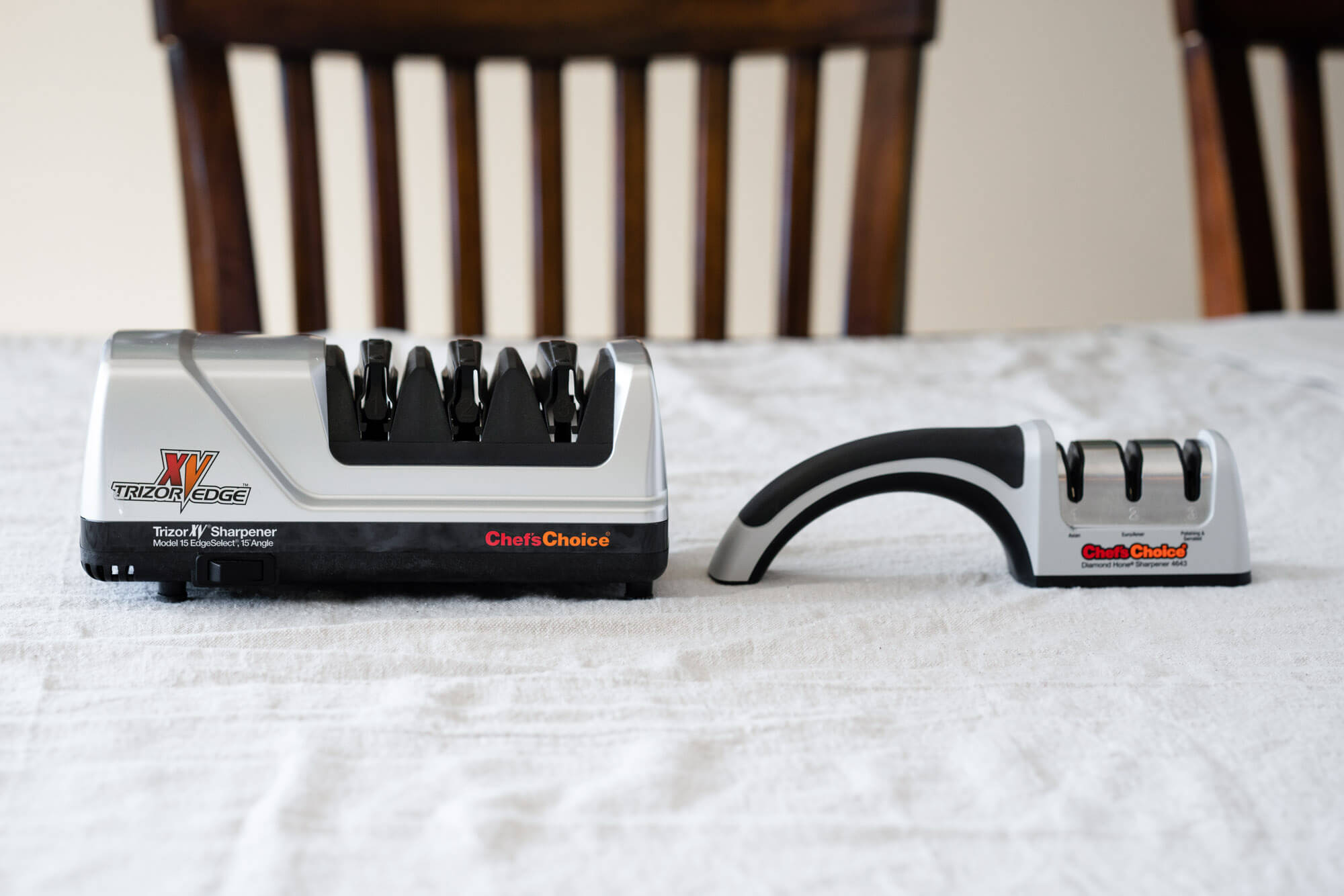
The better sharpeners include three stages: a stage-one coarse grind for reprofiling, a stage-two medium grind for refining, and a stage-three polish for edge cleanup. Terms vary among manufacturers, often designated as “sharpening, honing and polishing,” but the way each manufacturer accomplishes those three steps varies dramatically. You ideally want a sharpener that can perform all three stages so you can periodically use the medium grind and polish for maintenance, then use the coarse stage only when you see a chip or heavy wear.
Type of abrasives
For most kitchen sharpeners, the abrasive material is impregnated onto belts or metal disks. Abrasive grits range from coarse to medium to superfine. Whether electric or manual, the most common abrasives — in order of hardness — are diamond, alumina ceramic and tungsten carbide..
Abrasives wear out over time. Most will last for a reasonable amount of time (we see five years commonly quoted), again depending on individual use. Still, if you invest in a more expensive product, check to see if the abrasives can be replaced once they wear out. It’s also a perk if the device lets you swap out abrasives for different uses, like the Work Sharp’s accessory polishing belts.
Versatility
Each device offers different capabilities. Of products researched, the majority can sharpen serrated knives, but not all. Most can also sharpen pocket knives, but very few can accommodate scissors. And none can sharpen ceramic knives, which require a specialized device. So if you have specific needs, be sure to check for that function.
Cost
As with other products, the adage “you get what you pay for” applies to knife sharpeners as well. The difference here is that if you go too cheap, you risk damaging your knives, typically by chipping or scratching. It’s important to balance your sharpener investment against the quality of your cutlery.
Warranty
Manufacturer warranties are really only of concern with electric sharpeners, mainly due to their higher price and more complicated parts. Most electrics come with a one-year warranty. The exception is Chef’sChoice who offer up to three years on their high-end models.
How we tested
First we’ll describe our equipment, then the procedures.
A device to quantify sharpness
We included the popular paper slicing test you might have seen on YouTube. Though a good indicator of when a knife reaches decent sharpness, this test doesn’t clearly define how sharp one knife is relative to others. We wanted to go a step further and also obtain quantitative results.
Our research led us to the PT50B Professional Edge Tester. With this device, you stretch a wire filament across a small gap, then press a knife blade down on the filament until it severs. The PT50B measures the grams of downward pressure required to make the cut. This number indicates relative sharpness: the less downward force required, the sharper the edge.

The PT50B device works hand-in-hand with the Brubacher Edge Sharpness Scale (BESS), developed by Mike Brubacher at Edge On Up, makers of the PT50B. To interpret the numbers (in grams of pressure), we referred to the BESS “C” scale published at Bessu.org. Medical labs, factories and knife pros alike rely on this scale to evaluate sharpness.
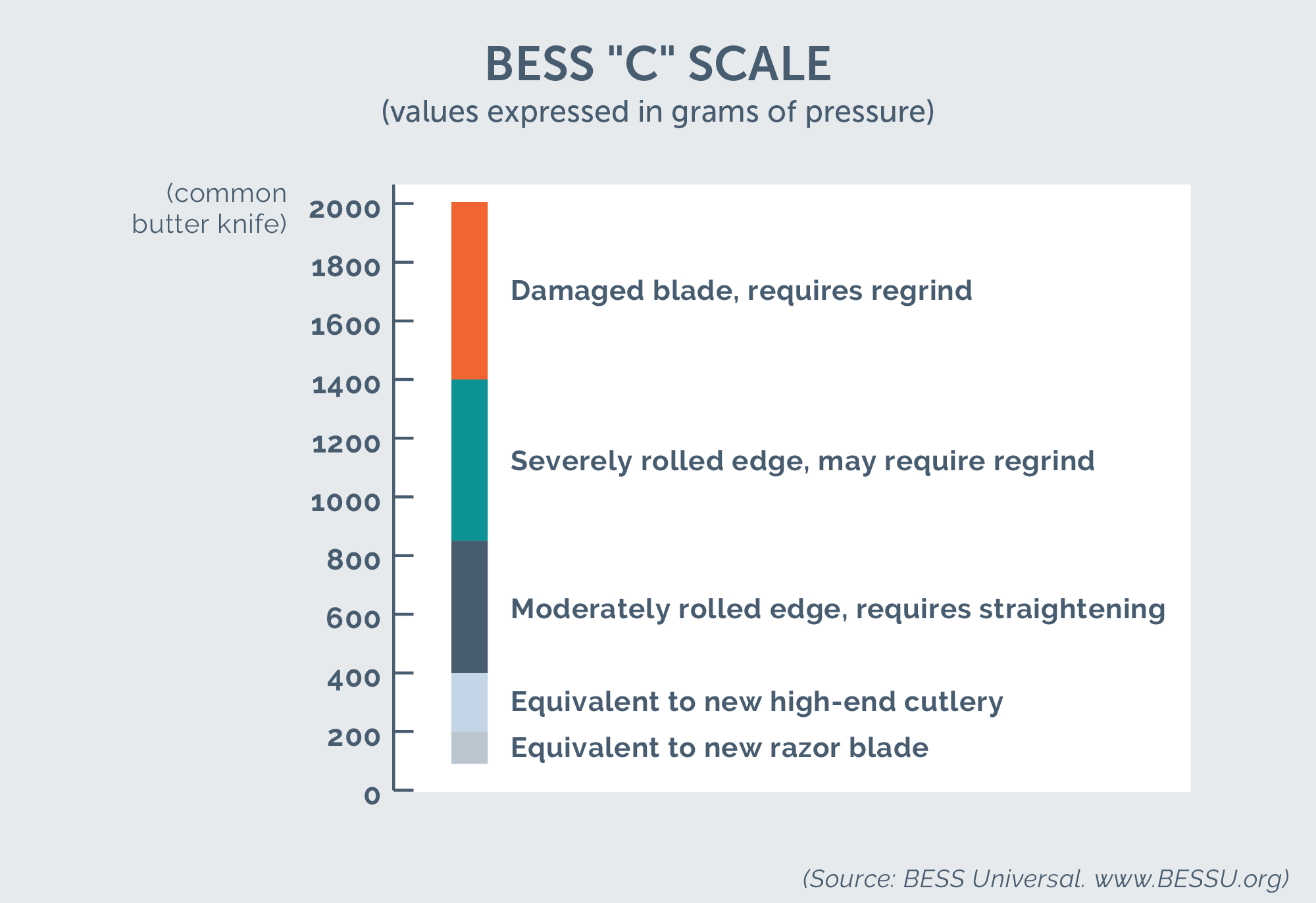
Calibrated to yield precise numeric results, the PT50B took the guesswork out of our testing. By taking a reading every certain number of passes, we could tell how quickly each knife became sharper as well as when the blade was ready for the next stage. It also helped us verify that each knife started at roughly the same level of dullness.
The BESS test doesn’t assess all the qualities of a knife edge, but it did help minimize bias in our results. For sake of comparison, we found that once a blade measured around 300-400 it had no problem at all effortlessly slicing through tomatoes.
Our sacrificial test knives
For knives, we purchased four Chicago Cutlery 3-piece knife sets. Each set included a 7.5” chef’s knife, a 5.5” utility knife, and a 3.5” paring knife. We used one knife set to test each of our four categories (two types of electrics, plus two types of manuals); this helped establish a level playing field. We also included an 8” thrift store knife, then rounded things out with a couple forged steel chef’s knives from our own collection.
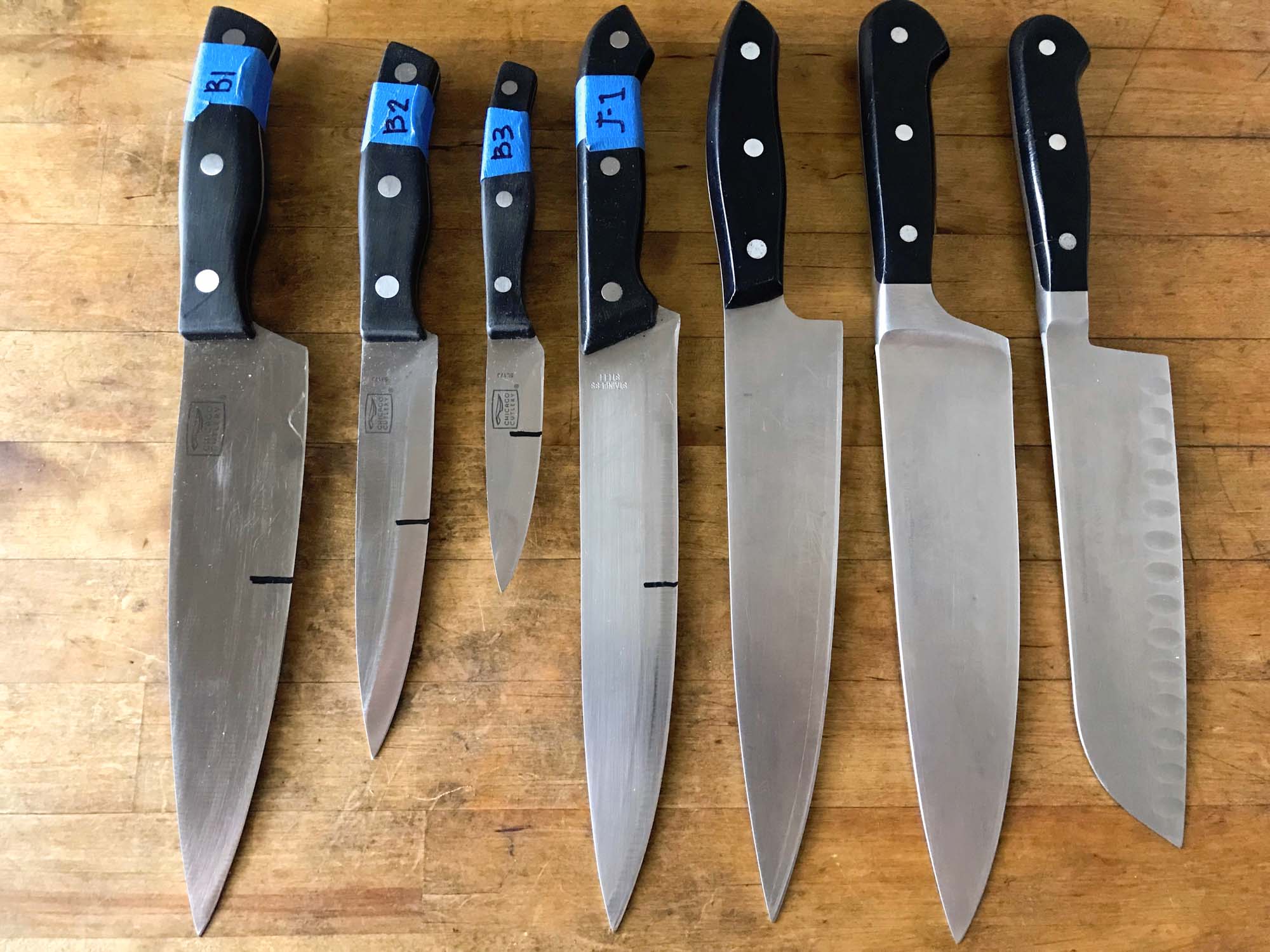
Our new knives were manufactured at a 15-degree edge bevel. But we assumed our older knives, all from the early 2000s, were closer to 20 degrees. We respected these angles to select the appropriate slot in each device.
Lastly, during our initial prep we learned that different points along an edge yield varying sharpness results. So we marked the midpoint of each blade with a Sharpie Marker to ensure that we tested each knife in roughly the same spot.
Edge dulling and restoration test

For our first test, we wanted to see which devices could restore a severely dulled edge. We began by blunting our brand-new, out-of-the-box knives on a concrete paver. Granted, this dulled our blades beyond what you’d see in a typical home kitchen, but it’s the same amount of work you’d have to do when repairing a chip or other severe damage back to a sharp edge. After about 25 strokes on the paver, all tested at around a 2000 on the PT50B, indicating they weren’t cutting into the wire at all.
Next, we put our sharpeners to work and followed specific manufacturer instructions. Every product has a different recommended technique, including number of passes per stage, types of strokes and amount of pressure on blade. To show the work required from the user, we counted each stroke — whether affecting one or both sides of blade — as a single pass.
After each recommended number of passes, which varied per device, we used a loupe to visually inspect for a burr. We diligently checked edges at roughly every 5-10 passes and recorded PT50B results to monitor progress. Once the knife was ready to proceed to next stage, we took three BESS readings for each data set and then averaged these numbers to account for margin of error. While the PT50B is accurate, we expected some deviation in the numbers simply because it’s nearly impossible to test the same microscopic point on the edge each time.
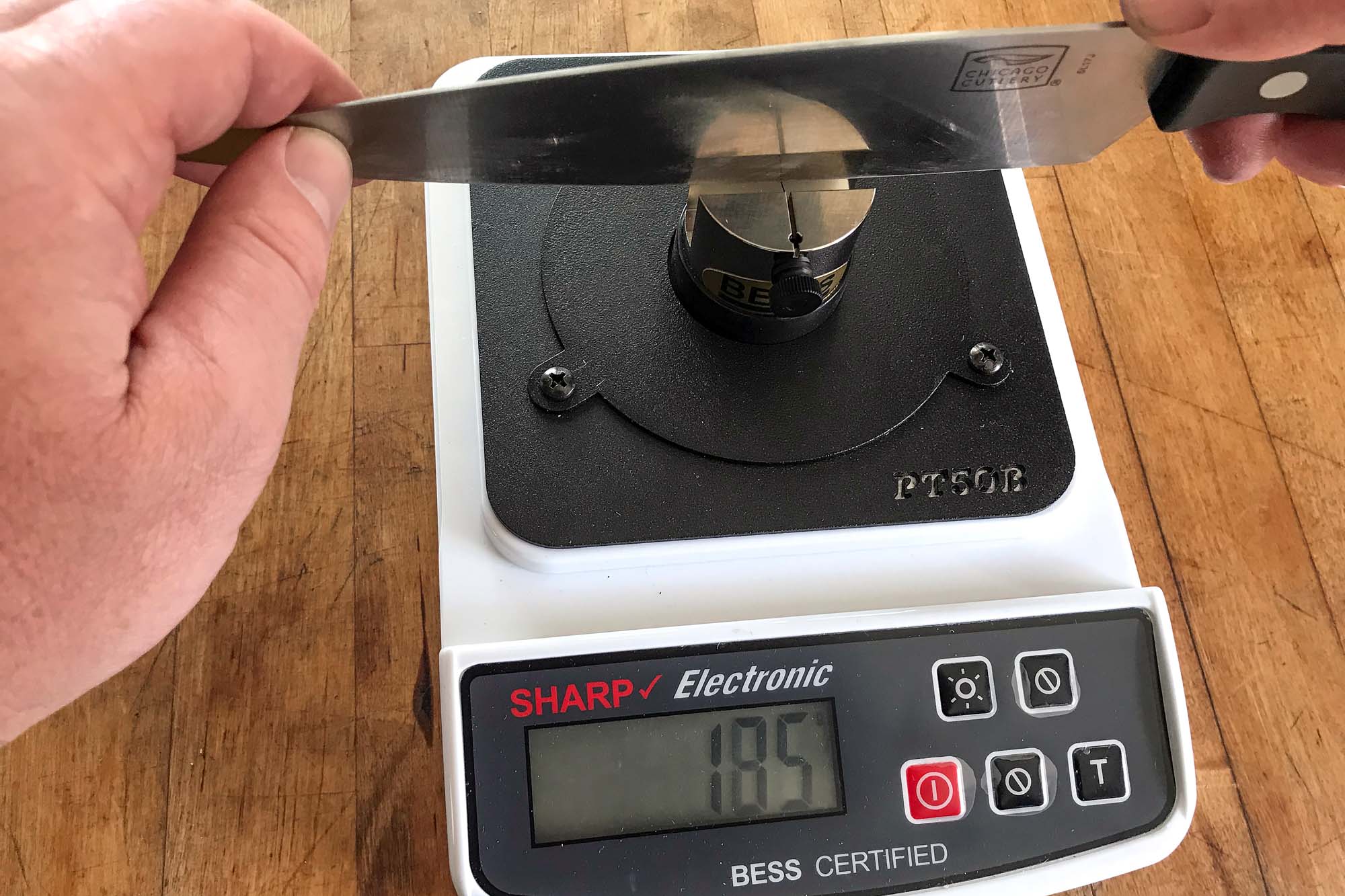
We found that all our devices required significantly more passes than described in product instructions. Some may, in fact, appear like ridiculously too many strokes. But we very methodically took a BESS reading at roughly every 10-20 passes — some more, some less, based on visual burr and subsequent readings — and this is truly how many strokes were required.
Again, to frame this fairly, we dulled our knives well beyond even what you’d see even on an edge that hasn’t been sharpened in a few years. Extreme as it was, this test demonstrates the advantage offered by powered sharpening systems: If they can give you a sharp edge in these conditions, they can handle just about anything.
Let’s also recognize that these brand new devices were tested with fresh abrasives, neither worn down nor metal laden — we can assume each performed as well as it could.
All five electrics were able to restore our dulled knives to a sharp edge. We confirmed this not only with PT50B measurements, but also by making sure each knife could effortlessly slice paper. The Chef’sChoice – AngleSelect 1520 and the Presto – EverSharp 08810 delivered best results and restored each type of knife. The Chef’sChoice – Trizor XV struggled with our old thrift store knife, but on our paring knife it measured the highest sharpness of all finalists. The Work Sharp and LINKYO products restored a sharp edge; however, we experienced awkward control issues with both (see below).
It’s worth sharing that the motors in all our electrics proved surprisingly quiet. Pulling knives through the abrasives was of course noisier, but not to a level that required earplugs.

As expected, our manual sharpeners didn’t fare quite as well as the electrics. A couple did okay with chef’s knives over 7”, but all dropped in performance as we progressed to shorter blades. The Brød & Taylor – Classic Sharpener was the standout — it restored our 7.5” chef’s knife to a sharpness level on par with the electrics; however, it didn’t do so well with our other test knives.
We were also surprised that the Chef’sChoice – ProntoPro 4643 reached a sharpness level that could cut paper, even though it took 420 strokes to get there. The same can’t be said for the GLOBAL – MinoSharp 3; after 700 strokes, it still couldn’t slice paper. As for the Spyderco – Tri-Angle Sharpmaker, the base package came with medium abrasives, but no coarse abrasives. The Sharpmaker’s medium-grit rods couldn’t put an apex on our blunted knife even after a frustrating amount of effort.
Edge maintenance test
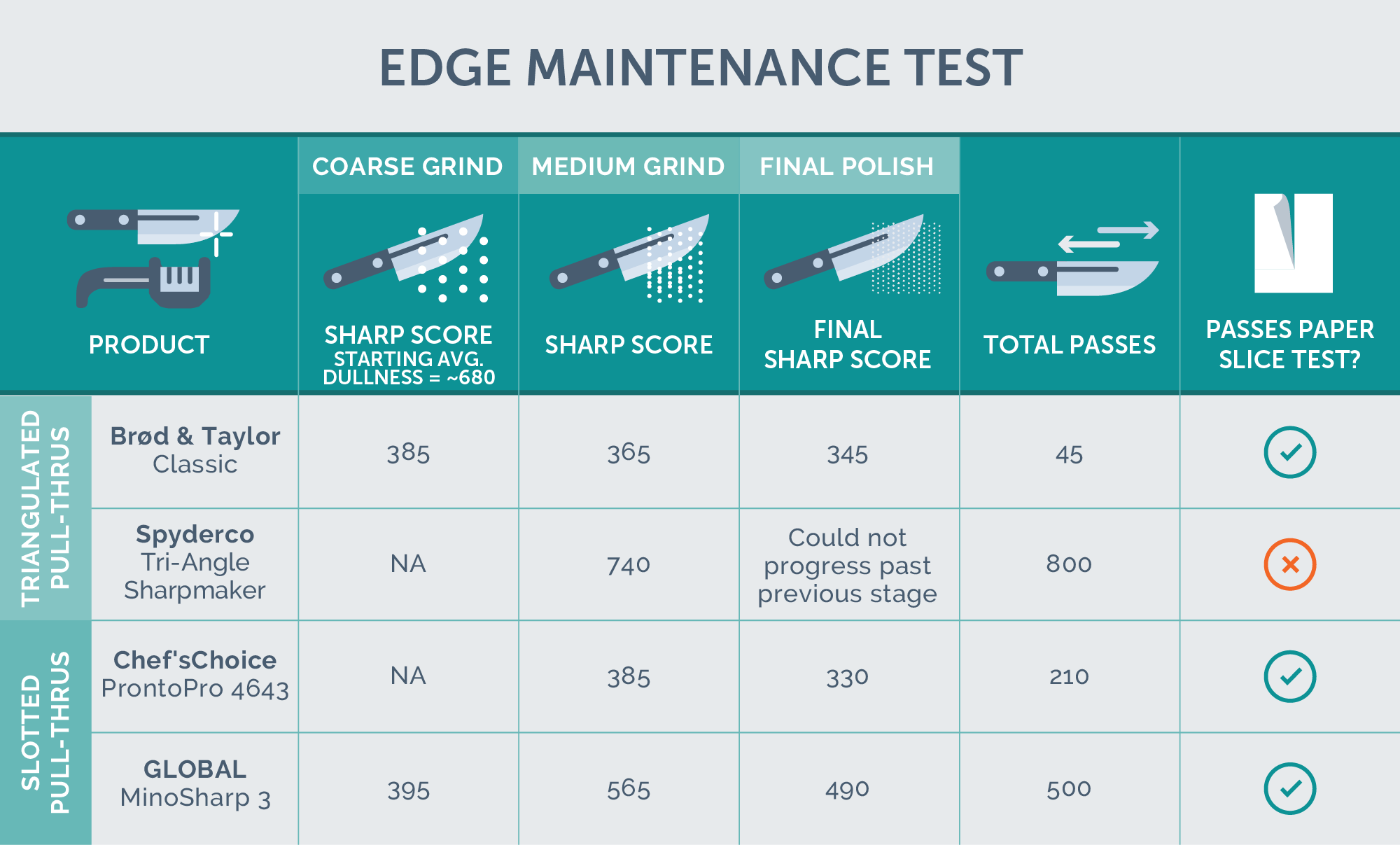
Our edge restoration test confirmed what we’d read: Manual pull-throughs struggle to reprofile a damaged edge. The abrasives are simply not coarse enough to grind down to a fresh apex. The exception is the tungsten carbide edge on the Brød & Taylor – Classic Sharpener, which turned out to be a star performer even for damaged blades. The other three manual devices require more passes than anyone should have patience for.
We wanted to give our manual pull-throughs a fair chance at doing what they’re best at, so we set up another test. This time we only dulled the blade to a “moderately rolled edge” as defined on the BESS “C” scale. We anticipated that at this level the devices wouldn’t need to work nearly as hard to succeed.
For this test, we again relied heavily on the PT50B to guide our process. We used it to confirm starting dullness and then took frequent readings. The Brød & Taylor again shined through, requiring remarkably fewer passes than the competition. It’s interesting that it needed 10 more passes than the more demanding edge restoration test, but the results remain impressive.
We were happy to see both the Chef’sChoice – ProntoPro 4643 and GLOBAL – MinoSharp 3 cut their required number of passes in half. The ProntoPro hit exactly the sharpness we were looking for, proving this is the task it’s more suited for. The MinoSharp 3 also performed much better, but not as well as the ProntoPro. And though it’s coarse stage did its job, we couldn’t get the medium or fine stages to show any improvement (in fact, our knife actually became less sharp).
We were hoping to see improvement from the revered Spyderco – Tri-Angle Sharpmaker. Based on a call to Spyderco’s tech support, we scrubbed the rods with Comet cleanser to remove any metal particle build-up and ensure best results. But that didn’t improve the medium-grit rods’ performance. After 400 passes on each side — alternating between corners and flat face of rods per the user manual — our PT50B readings indicated our knife was becoming duller than when we started, which led us to abort the mission.
Product ranking
As we put our finalists through their paces, we ranked each product by factoring in both our test data and firsthand experience. To assign scores, we considered these qualities and questions:
- Effectiveness: How efficiently can can it sharpen? How many passes required to achieve acceptable sharpness?
- Control: How easy is it to work the blade through each slot while maintaining consistent contact against the abrasive? Does it feel safe and under user control?
- Versatility: How many different angles can it sharpen? How many different types of blades?
- Build quality: Is it made with lots of plastic parts? Does it have a substantial feel?
How to sharpen a knife
At a most basic level, knife sharpening is all about reshaping a deformed steel edge back to a sharp apex. A thinner, more acute angle will slice or even push-cut more easily, while a thicker edge will stand up to more abuse. Either way, making sure the very apex of the edge is as refined as possible ensures its best performance.
With traditional techniques, you pass the blade over an abrasive surface; on each pass you alternate grinding from one side of the blade to the other. Knife sharpening has up to four stages depending on how sharp the blade is to start with.
Understand traditional sharpening stages
Grinding is the most aggressive stage and uses a coarse mineral abrasive (or even a hard scraping blade) to restore, or “reprofile,” a dull or damaged blade back to a sharp edge. When grinding, you gradually remove metal toward an acute apex as you flip the blade with each pass. This usually forms a “burr,” a ridge of foil-thin metal that hangs onto the edge when it’s as thin as it can get.
Polishing follows grinding as you move from coarse to medium to a fine-grit abrasive. For a quick glimpse of different grit levels that are out there, check out this stone grit chart. At this stage you refine the edge and remove imperfections. Polishing can also be a maintenance step to bring back that extra bit of sharpness after normal use wears your edge down.
Stropping removes any remaining burr after grinding and polishing. If you skip this step, the burr will fold back into a dull edge and possibly break off into your food. Stropping is traditionally done with a flexible strip of leather. Unlike the grinding stage where you push the knife edge forward, stropping is performed by dragging away from the edge.
Steeling does not remove metal but rather straightens the edge and burnishes it..
As a blade is subjected to impact through daily use, the edge can roll to one side. Steeling realigns the edge and is usually performed with a fine-tooth or smooth sharpening steel (thus the name “steeling”) and works best on knives with soft, tough steel. (Hard steel might just chip instead.) A ceramic or diamond abrasive “hone” is starting to replace this tool for many chefs, and will actually do some light polishing rather than just straightening the edge.
In most cases, you either grind, polish and strop to restore a dull or chipped blade, or you can use a steel to maintain an already fairly sharp knife throughout a day of heavy use. If you use knives with extra-hard steel, you will probably just want to polish-and-strop and make sure steels are kept far away from your knives.
Heavy grinding is typically only required if an edge is damaged. You really don’t want to overdo this coarsest stage because it reduces the lifespan of your knife. Edge maintenance, on the other hand, should be done frequently, as often as every couple of uses.
Choose a sharpening method
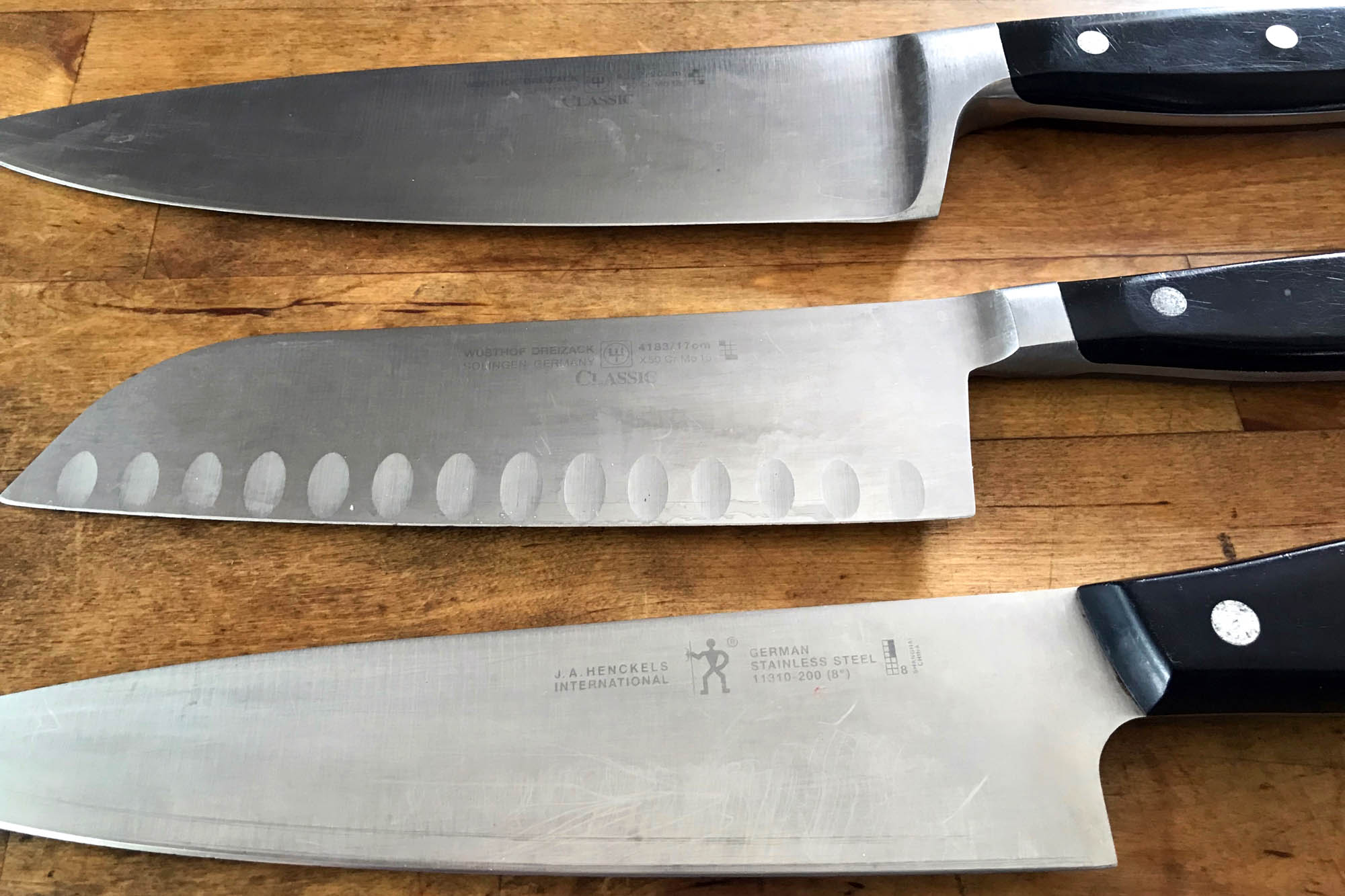
Knife sharpening options can be grouped into four categories.
Easy-to-use devices fall into two categories: countertop electrics and handheld manual pull-throughs. These devices are fast, convenient and require very little instruction. The main drawback is that most only sharpen to a specific edge angle, making them less versatile than other methods.
Whetstones are the traditional way to sharpen a knife. You alternately grind each side of the blade on a flat, abrasive stone that’s lubricated with water or oil, a sometimes messy procedure. This method relies heavily on technique and can take years to master.
Advanced systems range from complicated jigs to machines like water wheels and belt sanders. These tools let you sharpen to very precise edge angles, but they are expensive, require practice, and are best used at a garage workbench.
Professional services is the non-DIY option. Other people do the sharpening for you, but for a fee. We found that one-man shops favor traditional whetstones while larger companies use industrial machines. Though bringing or sending your knives to a service takes time, it’s still the best option for high-quality knives.
So which method is best for you? As mentioned earlier, we eliminated whetstones and advanced systems from consideration, as those methods require too much practice or cost too much money for the average home chef. For this review, we are focusing only on convenient methods — and that means either easy-to-use devices or professional services.
Professional knife sharpening services
This is the method you want to use for all your expensive cutlery. With this option, you rely on a skilled professional to handle your high-quality knives with care. Skilled cutlers greatly reduce the risk of damage. This is also a good option for any knives with handles that won’t fit in a home device.
The downside to professional sharpening is twofold: It costs money, and you have to get your knives to the shop. Most services charge around $4-$10 per knife; some charge by inches of blade length, others offer a discount if you sharpen as a bulk order. For transport, if you can’t find a local business, many services let you send by mail or courier and provide detailed instructions on how to safely package your knives.
Many people aren’t aware that knife manufacturers also offer sharpening service. Messermeister and Shun actually provide free lifetime service as part of their warranty (shipping costs excluded). Wüsthof, Henckels and MAC all offer sharpening for fees that are surprisingly reasonable. To share our research, we put together the following chart (bevel angles are for post-2015 product lines; see “Important features” if unfamiliar with bevels).

If you prefer to use a local service, perhaps for quicker turnaround, be sure to do your homework first. The danger is that if your high-end knives end up in unskilled hands, they could be damaged. We turned to Nate Ouderkirk at KitchenKnifeGuru for advice.
Nate is a big proponent of professional cutlers versus large commercial grinding services. Cutlers tend to be sole proprietors, which means you’re much more likely to receive personalized care. Most are highly skilled from many years of experience sharpening hundreds of blades. Best of all, they truly care about their craft so you can trust them with that $300 Bob Kramer Damascus knife.
We’d be doing a disservice if we didn’t also point out Nate’s recommendation for these five top services. We spoke with three of the five (Bob, Frank and Josh) during our research phase. All were highly professional, super friendly and incredibly knowledgeable.
Easy-to-use home kitchen sharpeners
Each of these product categories has a shallow learning curve, performs quickly and readily stores in a kitchen cabinet or drawer. In general, electric sharpeners are much better at edge restoration (i.e., returning a severely dulled blade to sharpness) but come at a higher price point. Manual pull-throughs are geared more toward edge maintenance and typically cost less than electrics.
Electric sharpeners
Of all these easy-to-use devices, countertop electrics perform the fastest. Unlike dated, single-slot models that sent sparks flying, today’s electrics are designed with improved abrasives and dedicated slots for coarse, medium and fine grinding. Most include guides that help position the blade for precise edge angles — but you’re limited to the bevels set by the included guides.
Electric sharpeners use motorized abrasive disks that remove metal faster than with whetstones or jig devices. That’s their key advantage: speed. So long as you don’t overuse the coarse stage, you can quickly restore a worn edge to a sharp apex. With the electrics that we tested, all warned not to use too much downward pressure, as that can wear away the abrasive disks and potentially remove too much knife metal.
Manual pull-throughs
Handheld sharpeners can be categorized as two types.
Triangulated rod pull-throughs position two abrasive-coated rods to form a V-shaped edge profile. You simply pull the blade through the “V” where the rods meet, using minimal downward pressure. Triangulated-rod devices come in many different designs; but in every case, you hold the knife vertical to maintain a consistent angle. Some models adjust for different edge angles.
Slotted pull-throughs are inexpensive and small enough to store in a drawer. Most models come with with two or three stages, with abrasives ranging from diamond to ceramic. Slotted pull-throughs lack the speed and power of electrics, which hinders their ability to restore a severely dulled blade. We encountered more than a few expert opinions complaining that fixed, V-shaped slots can chip and damage blades, so we stuck with products that use rotating disks (not motorized, just free-spinning).
The bottom line
Today’s consumer electric sharpeners and manual pull-throughs can’t replace a highly skilled cutler armed with a whetstone and lots of time to get the job done. But these easy-to-use kitchen devices certainly deliver on convenience, speed and economy.
The Chef’sChoice – AngleSelect 1520 ranked at the top for all four of our scoring categories: effectiveness, control, versatility and build quality. Some of our top performers struggled on certain knives, but the 1520 delivered consistently sharp results on old and new knives alike. It also outperformed its Chef’sChoice counterpart, the newer Trizor XV. Even if most of your knives aren’t manufactured to a 20-degree angle, it’s nice to have that option in case you want to set a wider bevel to last longer for cutting bone-in meats or tough vegetables.
Scoring in second place, we were surprisingly impressed by the Presto – EverSharp 08810. For a budget-priced model, it sharpened our test knives in significantly fewer passes than all other electrics.
Looking to our manual devices, the Brød & Taylor – Classic Sharpener is a versatile, capable improvement of the steel chefs and butchers have always relied on. It doesn’t polish an edge the way fancy abrasives will, but it’s very capable at scraping and burnishing to a sharp apex.
Top Pick: Chef’sChoice - AngleSelect 1520
Driven by a powerful motor, the 1520’s diamond abrasive disks quickly sharpen dull blades to cut like new again. Its hybrid design accommodates both 15- and 20-degree knives, a rare flexibility in electric sharpeners. The 1520 has a substantial feel yet remains easy to store.
More Reviews
The 8 Best Salt and Pepper Grinders
Merazi Living
Blue Apron
The 7 Best Tea Makers (Hot & Iced)
Breville - BTM500
Dash - JB065AQ
The Best Dry Food Storage Containers
Progressive - Prepworks
The 12 Best Food Storage Containers
OXO Good Grips - Smart Seal
Nexus - BD1N
KitchenAid - KSM150P
ThermoWorks - Thermapen
Cuisinart - MSC-600



